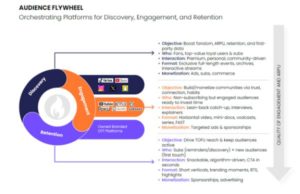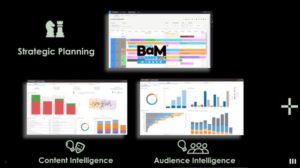
Olivier Karra
Cloud Solutions Marketing Director at Broadpeak
The video streaming industry is in the midst of an evolution, with several challenges facing service providers. Yesterday, service providers were focused on providing stable and robust streaming services. Today, they are looking to match streaming QoE with broadcast QoE, at scale. In the future, personalization and contextualization will be the norm, combined with a high degree of agility.
Keeping Up With the FAANG
Overall, staying ahead in this market means reaching the same speed of development as the FAANG. In finance, FAANG is an acronym that refers to five prominent American technology companies: Facebook, Amazon, Apple, Netflix, and Google. Because of their scale (tens of thousands of software engineers) and global footprint, these companies are setting the pace at an unprecedented level, which is extremely challenging for most other players to match. Without removing the need to innovate, leveraging the same kind of technology, tools, processes, services, and business models is therefore becoming key to remaining competitive.
Overall, those challenges apply to all streaming service providers. Whether you are a content provider going direct-to-consumer, a programmer, an operator such as MVPD or ISP with your own cable or telco network, or an aggregator, you will be impacted at some point. The sooner you anticipate this, the less risk you are exposed to.
What Technology, Tools, and Services Can Make the Difference?
The following approaches are key ingredients to remain or to become successful:
- AI and analytics can help you anticipate needs, identify patterns, perform cohorts mapping, and make proactive changes
- SaaS API platforms allow you to easily outsource complicated projects, build your services on top of it, and leverage the opportunity to automate (almost) everything
- CI-CD aids in building on top of something existing and enables you to be in control in an agile way
- A/B testing is a great way for you to find your sweet spot leveraging end users’ analytics

CI-CD aids in building on top of something existing and enables control in an agile way
What Does it Translate Into From a Business Standpoint?
Keeping up with FAANG speed basically means you need to answer the following questions:
- How can you shorten your cycles and make agility become part of your DNA?
- How to create more value faster for your customers?
- How to assess product potential very early in your business cycles?
- Identifying business models naturally aligned with this approach
A lot of the answers to those questions are pointing towards SaaS. Building streaming platforms on top of such cloud services basically introduces the ability to evaluate, trial, deploy and go to market within extremely short timescales.
Adding on-boarding, customization, operations, training and support services on top allows you to go one step further with mSaaS (managed SaaS). The TV industry is indeed too complex to be exclusively approached from a pure SaaS standpoint. With this context in mind, using mSaaS from companies who care can be a smart move, at least to secure key transformation phases or to accelerate go-to-market cycles.
In both cases, native continuous integration, delivery and deployment processes ensure a high degree of automation and adaptability for any service using such foundations. Those options basically represent very safe, rapid and efficient paths to build a streaming platform or to propose new services on top of existing platforms.
Here a few points to keep in mind. Although SaaS is the way to go for a growing number of use cases, it's important to avoid partners that will consider you as a SMB opportunity. For operators wanting to host and leverage such technology on their own infrastructure or cloud environment, a first phase based upon a SaaS or managed service can be seen as an accelerator, giving you time to study alternative deployment environment options. Operators wanting to migrate from one environment or ecosystem to another have the opportunity to smoothly transition and avoid duplicating infrastructure, even partial, with such SaaS-based services.
Applications as a Service
While "functions as a service" SaaS are key components to build upon, "applications as a service" SaaS integrate more value. They allow you to focus on how to create value faster and sooner without removing the ability to customize and automate your workflows.
The key point, in this case, is to ensure you are using a true API video platform as all the automation you may build in your workflows for applying provisioning, changes, and updates would otherwise be lost.

Managed services dashboard
Let’s take the blackout use case as an example. In this situation, a linear feed with original content needs to be blacked out or replaced during specific time slots. It typically applies to some live sports events when a content provider’s distribution rights are restricted.

With the “function as a service” approach, integrating a whole set of complex individual elementary services (e.g., manifest manipulation, audience logic vs. rules and policies, content preparation and normalization, etc.) can require significant efforts.
Blackout application as a service, on the other hand, allows you to immediately focus on more value-added features such as:
- Personalizing replacement content to improve QoE
- Monetizing eyeballs time during occultation slots
- Leveraging audience-based analytics to dynamically minimize churn
- More generally, be ready for whatever programmers or regulators may impose (example: FCC with EAS emergency alert service in the U.S.)
While the blackout as a service application has already been proposed by Broadpeak to a customer, it shows that building on top of cloud services puts the focus on what matters most.
Takeaway
While the streaming content offering has never been so plethoric, the need to differentiate from ubiquitous competition and to remain visible has never been so acute. Ultimately, anticipation of market evolution and shortening of product and feature launch cycles must be part of every streaming provider strategy.
API-controlled SaaS and managed services built on top are a very efficient means to quickly adapt and to automate advanced streaming workflows at scale. The cherry on the cake is that the risk is extremely low both from a time spent and from an investment standpoint compared with other traditional approaches.
Bottom line, although there is no unique approach, leveraging some of these application-centric services can be a game changer for your business.
To conclude with a concrete example, Broadpeak has joined the AWS SaaS factory program to go through this very transformation. With the peakVU.TV platform, Broadpeak is also in a position where it operates a white-label video streaming platform based upon its own cloud media technology. While every company needs to have its own strategy to tackle the challenges of transitioning toward DevOps, CI-CD and SaaS-based operations, the experience of building both API cloud media services, and a commercial streaming platform upon it, is one of the most unique learnings that Broadpeak has had, and we look forward to sharing it.









